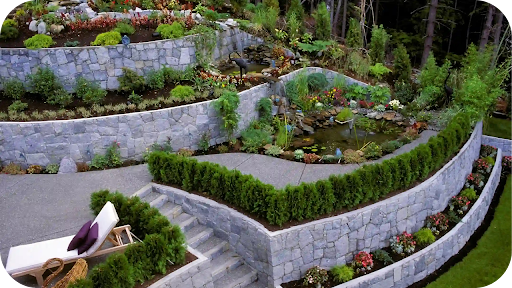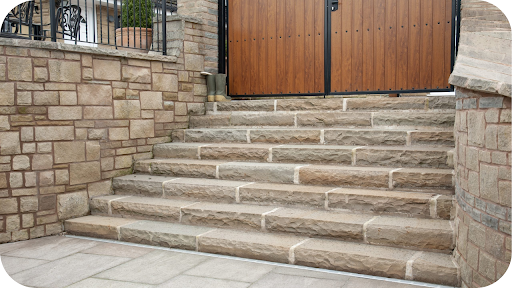Eco-Friendly Stone Retaining Walls
Eco-friendly stone retaining walls bring together sustainability and style, offering a durable solution for landscapes that value environmental responsibility. They are designed to last while reducing negative ecological impact.
Using locally sourced or reclaimed stone, these walls blend naturally with the surroundings and support biodiversity. They also provide practical benefits, including erosion control, improved drainage, and structural stability over time.
With their timeless appearance and minimal maintenance needs, they are becoming a preferred choice. This article covers materials, designs, installation methods, and the benefits of building sustainably.
What Makes a Stone Retaining Wall Eco-Friendly?
An eco-friendly stone retaining wall is defined by the way it is sourced, constructed, and maintained to minimise environmental impact. Choosing sustainable materials is key, with locally quarried stone or reclaimed stone reducing transportation emissions and conserving resources.
Using naturally durable stone helps avoid excessive processing and limits the need for cement or synthetic additives, which carry a higher carbon footprint. These walls are often designed to work with natural drainage patterns, preventing erosion without disrupting ecosystems.
They can also be integrated into landscapes in a way that supports native plants and wildlife, ensuring the finished structure blends seamlessly with its surroundings. The result is a retaining wall that balances beauty, performance, and genuine environmental responsibility.
Benefits of Choosing an Eco-Friendly Stone Retaining Wall
Eco-friendly stone retaining walls are more than just a functional structure. They are a sustainable investment that benefits your property and the planet. Here is why choosing one can be a smart long-term decision:
1. Reduces Environmental Impact
Eco-friendly stone retaining walls use sustainably sourced or reclaimed materials. This lowers your project’s carbon footprint and helps conserve resources. By avoiding non-renewable or heavily processed materials, you also reduce environmental harm during and after construction.
2. Enhances Natural Drainage
When designed with permeability in mind, stone retaining walls allow rainwater to pass through naturally. This reduces soil erosion, prevents water pooling, and supports healthier surrounding vegetation without the need for artificial drainage systems or excessive maintenance.
3. Offers Long-Lasting Durability
Sustainably sourced stone is naturally resistant to weather, wear, and pests, meaning fewer repairs and replacements over its lifespan. This durability not only saves money but also minimises waste from discarded materials over the years.
4. Supports Biodiversity
Eco-friendly retaining walls can be integrated with native plants and greenery. This creates habitats for local wildlife, supports pollinators, and helps maintain a balanced ecosystem while keeping your landscape visually appealing and environmentally responsible.
5. Increases Property Value
Homeowners and buyers are increasingly drawn to sustainable features. An eco-friendly stone retaining wall enhances curb appeal while showcasing environmental awareness, making your property more attractive and potentially increasing its resale value in the long term.
Best Sustainable Stone Options for Retaining Walls
Eco-friendly retaining walls thrive with the right stone. Each brings distinct aesthetics, durability, and sustainability suited to varied landscapes and conditions. Here are some of the best choices.
1. Granite
Granite is exceptionally dense and resistant to harsh weather, making it ideal for retaining walls in exposed or high-traffic areas. Options such as Buffalo granite in golden-grey tones and Hotham granite with tightly stacked patterns provide both structural integrity and timeless style.
2. Limestone
Limestone’s warm, natural tones blend effortlessly with gardens, bushland, and heritage-style settings. Varieties like Jamieson limestone with golden-brown tones and Beloka limestone featuring deep grey and gold highlights combine strength with an inviting, organic appearance.
3. Sandstone
Sandstone offers an earthy texture and enduring charm that pairs well with native plantings and natural landscapes. Charlotte sandstone in soft beige and Australiana sandstone with creamy white and rust-toned accents bring visual warmth while maintaining solid performance.
4. Quartz
Quartz stands out for its strength, longevity, and diverse colour range that suits both contemporary and traditional designs. Shoreham quartz in soft white, grey, and peach tones and Blue Ridge quartz with cool greys and gold accents deliver striking visual depth.
5. Travertine
Travertine combines elegance with resilience, working well in both refined and relaxed outdoor designs. Sorrento travertine in soft cream and Silver travertine in a blend of grey and beige create a smooth, sophisticated finish with lasting durability.
Designing a Retaining Wall That Works With Nature
Designing eco-friendly stone retaining walls means working with, not against, the land’s character. Each technique supports sustainability and landscape harmony. The following design approaches deliver both beauty and environmental value.
1. Blend with Existing Terrain
Shaping a retaining wall to follow the land’s natural contours reduces excavation needs and preserves the original character of the site. This approach minimises environmental disruption while achieving a harmonious connection between the wall and its surrounding environment.
2. Support Native Plants and Wildlife
Incorporating ledges, gaps, and soil pockets within the wall design provides habitats for local flora and fauna. This creates a living wall effect that fosters biodiversity and enriches the ecological value of your outdoor space.
3. Create Terraces for Better Land Use
Designing multiple levels within the wall maximises usable space while aiding water management. These terraces can be planted with native greenery, transforming functional retaining structures into vibrant, eco-supportive areas that integrate beautifully into the landscape.
4. Integrate Natural Drainage Features
Including gravel backfill, weep holes, or strategically placed permeable sections supports natural water flow. This method prevents water build-up, reduces erosion risk, and maintains healthy soil conditions, extending the lifespan of the wall and its surroundings.
5. Use a Mix of Stone Textures and Sizes
Combining different stone shapes and finishes creates visual interest while improving structural stability. This approach reflects the diversity of natural landscapes and allows the wall to blend more authentically into its environment.
Eco-Conscious Construction Methods
Building sustainably is about using techniques that protect the environment while maintaining structural integrity. Below are some effective construction approaches that align with eco-friendly goals:
- Building with Dry-Stone Walls: Constructing walls without cement minimises carbon emissions and allows natural water drainage. This traditional method also offers flexibility for repairs, supports stone reuse, and blends seamlessly into natural landscapes over time.
- Using Low-Impact Excavation: Employing minimal machinery and targeted digging preserves surrounding soil structure, reduces habitat disruption, and maintains the natural balance of the site while ensuring work is completed with minimal ecological disturbance.
- Applying Efficient Material Cutting: Precision cutting of stone reduces off-cuts and overall waste. This approach maximises usable material, lowers the environmental footprint, and ensures cleaner, more efficient construction without sacrificing quality or durability.
- Using Locally Sourced Stone: Selecting stone from nearby suppliers decreases transportation emissions, supports local industry, and ensures the wall reflects the natural character of the region while maintaining authenticity and long-term sustainability.
- Designing Permeable Walls: Incorporating gaps for water flow prevents soil erosion, supports groundwater replenishment, and reduces stormwater system pressure, allowing the structure to perform effectively while blending naturally with the environment.
Care and Maintenance Tips for Eco-Friendly Retaining Walls
Sustainable retaining walls are low-maintenance, but a few simple practices will keep them performing well and looking great for years. Here are the most effective care tips to follow:
- Inspect regularly for damage: Look for cracks, loose stones, or signs of movement, and carry out repairs quickly to prevent further structural weakening and maintain both safety and visual appeal.
- Keep drainage clear: Regularly clear leaves, soil, or debris from drainage outlets to ensure proper water flow, reducing the risk of erosion, waterlogging, or long-term damage to the wall’s foundation.
- Clean with eco-safe products: Use biodegradable cleaning agents to gently remove moss, algae, and dirt, ensuring the surface remains attractive while protecting surrounding vegetation and preventing harm to local ecosystems.
- Maintain surrounding greenery: Trim plants, control invasive roots, and remove overgrowth to avoid pressure or damage to the wall, preserving its strength and overall aesthetic in the landscape.
- Reposition displaced stones: Check for stones that have shifted out of place and carefully realign them to maintain the wall’s stability, original structure, and intended design balance.
Lasting Strength with Sustainable Design
Choosing eco-friendly stone retaining walls is an investment in durability, beauty, and environmental responsibility. By selecting sustainably sourced stone, you reduce your ecological footprint while creating a feature that adds both strength and timeless elegance to your landscape.
When paired with expert installation, your wall becomes a long-lasting structure that supports your garden, enriches outdoor spaces, and protects the planet for future generations. Splendour in Stone provides premium eco-conscious materials and skilled craftsmanship to turn your vision into reality. Start your journey toward a sustainable landscape by contacting us today and discover how quality and care can work hand in hand with nature.




